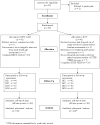Multisystemic Therapy for Child Abuse and Neglect: a randomized effectiveness trial
- PMID: 20731496
- PMCID: PMC2928578
- DOI: 10.1037/a0020324
Multisystemic Therapy for Child Abuse and Neglect: a randomized effectiveness trial
Abstract
The primary purpose of this study was to conduct a randomized effectiveness trial of Multisystemic Therapy for Child Abuse and Neglect (MST-CAN) for physically abused youth (mean age = 13.88 years, 55.8% female, 68.6% Black) and their families. Eighty-six families being followed by Child Protective Services due to physical abuse were randomly assigned to MST-CAN or Enhanced Outpatient Treatment (EOT), with both interventions delivered by therapists employed at a community mental health center. Across five assessments extending 16 months post baseline, intent-to-treat analyses showed that MST-CAN was significantly more effective than EOT in reducing youth mental health symptoms, parent psychiatric distress, parenting behaviors associated with maltreatment, youth out-of-home placements, and changes in youth placement. Also, MST-CAN was significantly more effective at improving natural social support for parents. Effect sizes were in the medium to large range for most outcomes examined. Although fewer children in the MST-CAN condition experienced an incident of reabuse than did counterparts in the EOT condition, base rates were low and this difference was not statistically significant. The findings of this study demonstrate the potential for broad-based treatments of child physical abuse to be effectively transported and implemented in community treatment settings.
Figures
Similar articles
-
Comprehensive treatment for co-occurring child maltreatment and parental substance abuse: outcomes from a 24-month pilot study of the MST-Building Stronger Families program.Child Abuse Negl. 2013 Aug;37(8):596-607. doi: 10.1016/j.chiabu.2013.04.004. Epub 2013 Jun 12. Child Abuse Negl. 2013. PMID: 23768938
-
Multisystemic Therapy - Building Stronger Families (MST-BSF): Substance misuse, child neglect, and parenting outcomes from an 18-month randomized effectiveness trial.Child Abuse Negl. 2021 Dec;122:105379. doi: 10.1016/j.chiabu.2021.105379. Epub 2021 Nov 3. Child Abuse Negl. 2021. PMID: 34742002 Clinical Trial.
-
[Multisystemic therapy for child abuse and neglect (MST-CAN): description of the treatment, psychiatric morbidity, and the psychiatrist's role].Tijdschr Psychiatr. 2015;57(8):561-8. Tijdschr Psychiatr. 2015. PMID: 26402891 Dutch.
-
Multisystemic Therapy for Externalizing Youth.Child Adolesc Psychiatr Clin N Am. 2015 Jul;24(3):601-16. doi: 10.1016/j.chc.2015.02.007. Epub 2015 Mar 29. Child Adolesc Psychiatr Clin N Am. 2015. PMID: 26092742 Free PMC article. Review.
-
Multisystemic therapy for child non-externalizing psychological and health problems: a preliminary review.Clin Child Fam Psychol Rev. 2013 Mar;16(1):81-99. doi: 10.1007/s10567-012-0127-6. Clin Child Fam Psychol Rev. 2013. PMID: 23385370 Free PMC article. Review.
Cited by
-
Maltreatment, family environment, and social risk factors: Determinants of the child welfare to juvenile justice transition among maltreated children and adolescents.Child Abuse Negl. 2017 Jan;63:7-18. doi: 10.1016/j.chiabu.2016.11.013. Epub 2016 Nov 22. Child Abuse Negl. 2017. PMID: 27886518 Free PMC article.
-
Posttraumatic stress in school-age children and adolescents: medical providers' role from diagnosis to optimal management.Pediatric Health Med Ther. 2015 Oct 3;6:167-180. doi: 10.2147/PHMT.S68984. eCollection 2015. Pediatric Health Med Ther. 2015. PMID: 29388603 Free PMC article. Review.
-
Reducing mental health disparities among racially and ethnically diverse populations: A review of couple and family intervention research methods (2010-2019).J Marital Fam Ther. 2022 Jan;48(1):346-365. doi: 10.1111/jmft.12573. Epub 2021 Dec 2. J Marital Fam Ther. 2022. PMID: 34854480 Free PMC article. Review.
-
Predictors, Moderators, and Treatment Parameters of Community and Clinic-Based Treatment for Child Disruptive Behavior Disorders.J Child Fam Stud. 2015 Mar;24(3):734-748. doi: 10.1007/s10826-013-9884-1. J Child Fam Stud. 2015. PMID: 25750506 Free PMC article.
-
Mobilising social support to improve mental health for children and adolescents: A systematic review using principles of realist synthesis.PLoS One. 2021 May 20;16(5):e0251750. doi: 10.1371/journal.pone.0251750. eCollection 2021. PLoS One. 2021. PMID: 34015021 Free PMC article.
References
-
- Achenbach TM. Manual of the Child Behavior Checklist and 1991 Profile. Burlington: University of Vermont, Department of Psychiatry; 1991.
-
- Black DA, Heyman RE, Slep AMS. Risk factors for child physical abuse. Aggression and Violent Behavior. 2001;6:121–188. doi: 10.1016/S1359-1789(00)00021-5. - DOI
-
- Boulet J, Boss MW. Reliability and validity of the Brief Symptom Inventory. Psychological Assessment: A Journal of Consulting and Clinical Psychology. 1991;3:433–437. doi: 10.1037/1040-3590.3.3.433. - DOI
-
- Briere J. Trauma Symptom Checklist for Children. Odessa, FL: Psych Assessment; 1989.


